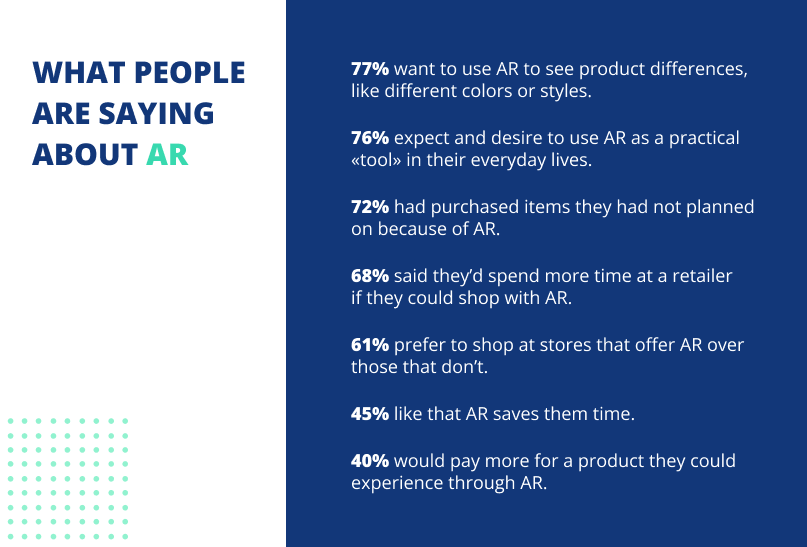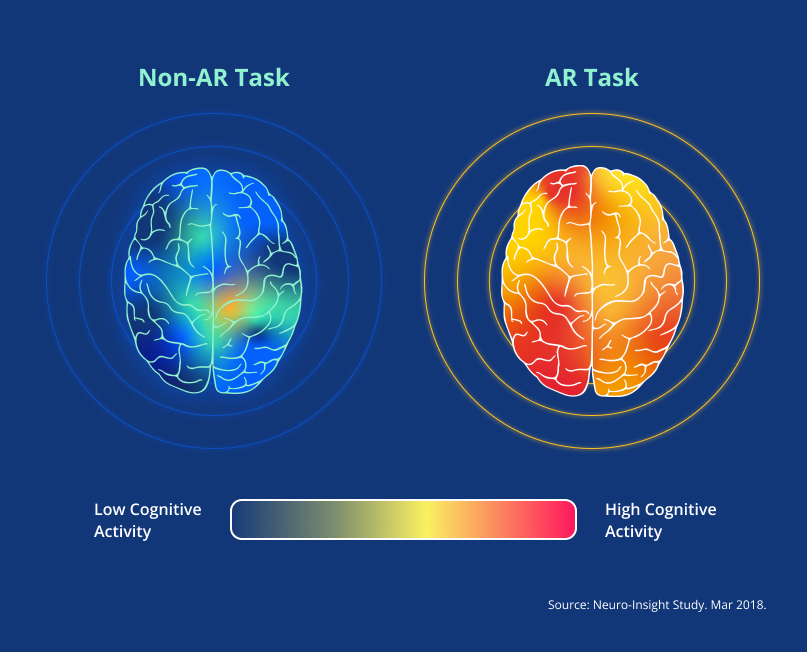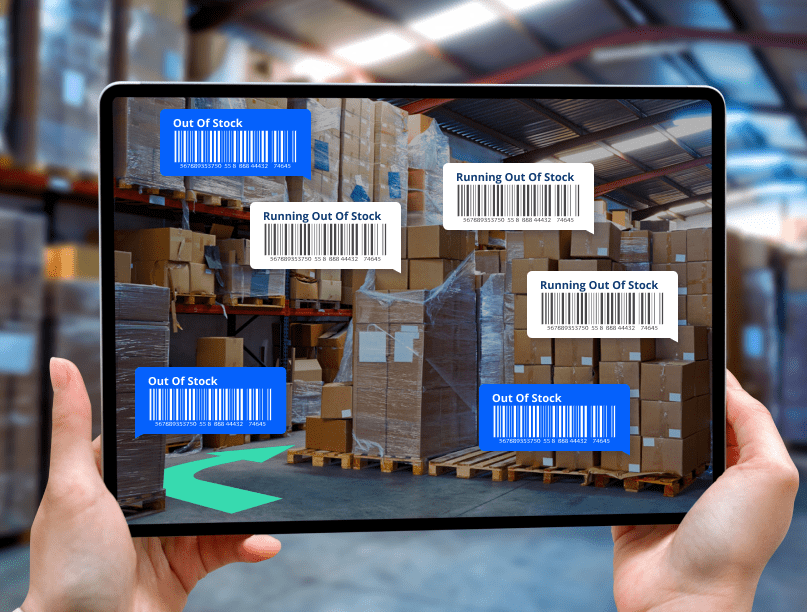The consequences of the pandemic, changes in consumer habits, and the growth of online shopping collectively resulted in an apocalyptic effect for retailers and their stores.
These days it is not enough to simply be aware of the customer’s needs and leverage traditional approaches. On the contrary, to remain ahead of the competition, retailers must learn to foresee customer wishes and upcoming trends. The only way to do this is to be ahead of time and invest in technical solutions to conquer the modern market.
In the modern world, routine visits to stores or shopping centers are increasingly becoming a waste of time. Mark Kennedy once said, “All of the biggest technological inventions created by man — the airplane, the automobile, the computer — says little about his intelligence but speaks volumes about his laziness.”
If a particular technology makes people’s lives easier, it is destined to be a success. Augmented reality is considered to be such a technology. With the help of AR, people can tour the Egyptian pyramids at the Thomas Cook Agency, view an Audi virtual showroom from the comfort of their homes, or simulate their own virtual kitchen equipped with the latest IKEA furniture.
In a market where competitors offer similar products within the same price range, brands must strive to differentiate themselves. However, most business people ask themselves: Is investing in augmented reality application development worth it? What benefits of AR justify the investment of time, money, and resources? So, before investing in this technology, you should clearly understand what augmented reality is and how AR can aid your brand. In this article, we will cover the precise benefits you can expect from implementing AR in your retail.
Augmented Reality in Retail & E-commerce: The Stats
Augmented reality software can be a powerful weapon to fight for your place in the realm of retail:
The Benefits of Augmented Reality in Retail and E-commerce
AR increases conversion and sales
AR can help you sell more. According to Shopify, brands using augmented reality saw retail conversion rates increase by around 250%. This is because customers can choose any object and move it around the house or try on clothes. According to Adi Tatarko, Houzz’s CEO, customers who used AR spent 2.7 times more time on the app and purchased 11 times more often.
AR drives sales of other products
One of the consumer’s primary concerns is ensuring certain categories of products, such as furniture, generally fit perfectly with their interior design. From a customer’s perspective, AR-based applications can help make effective design decisions. Before purchasing the product, the buyer can check if a particular piece of furniture fits into the room and if it matches the interior. Such AR applications help decorate entire rooms and spaces. For a retailer, this is an ideal opportunity to collect data and offer products with a similar design. Therefore, instead of buying just a single sofa, the client might additionally buy a wardrobe, a table, or supplementary interior items.
AR reduces product returns
According to Statista, online returns are a major hassle for retailers since it results in $550 billion worth of losses. This is a huge problem — however, there are many reasons standing behind this. The main reasons include the product not fitting in size, color, shape, or even looking differently compared to what was shown in the picture.
Augmented reality deeply affects decision-making by reducing confusion, frustrations, and subsequent good returns. When customers can see how a product will look in their homes or bodies before making a purchase, they are more likely to be satisfied with the product. Consequently, when they get the product, they have fewer reasons to return it. With this “try before you buy” strategy, businesses can improve their conversion rates and reduce the return of goods. For instance, Shopify recorded a 40% drop in returns thanks to AR and 3D visualization.
Augmented reality is known to have a remarkable impact on customers purchasing from some product categories for the first time. People tend to rely more on AR to reduce the risk of buyers’ frustration when they are unfamiliar with a product.
AR helps sell less popular and more expensive products
Less popular and too expensive products usually capture a narrow target audience. Such clients are sometimes called “long tail” since only a few of them are willing to buy. However, with augmented reality, the number of sales for such products increases. Customers feel more comfortable and relaxed when they can explore unfamiliar products with AR. Therefore, vendors can leverage augmented reality to stimulate demand for niche or premium products by reducing consumer fear of an unfamiliar product category.
AR helps to attract new clients
A large percentage of the population is still restricted from going out because of the pandemic. Thus, by creating AR-based applications, you can provide isolated people with a unique experience of buying the necessary goods —regardless of potential limitations, including the pandemic, geographic location, or disability.
AR helps customers remember your brand and return to shopping
Findings from a number of cognitive indices demonstrated an almost double (1.9 times) engagement in people using AR compared to the group using similar but not AR-based apps. The results clearly demonstrate AR’s ability to generate a more powerful customer response. Therefore, we conclude that AR improves memory and produces more powerful consumer responses. Furthermore, this means that the client is more likely to remember you and return.
AR can improve the efficiency of your employees and customer experience
One of the most significant benefits of augmented reality is that it produces a one-of-a-kind digital experience that combines the best of the digital and physical world. In fact, customers have been conditioned to judge a brand’s quality primarily by how well it delivers digital experiences. AR can be experienced with standard smartphones and mobile apps. The most recent advancements in augmented reality now enable consumers to access immersive experiences through web browsers.
AR can add innovation to your production and, thereby, increase the efficiency of your employees — by making their work more accurate and less labor-intensive. The AR system provides real-time barcode scanning, indoor navigation, seamless data integration with the warehouse management system, and object recognition. These features can help employees:
- Check prices and product location, and quickly deliver goods to customers. An employee scans a barcode from a customer’s receipt and locates the order in the warehouse using navigation arrows and hints. This allows order pickers to find the right items for customers much faster in a crowded warehouse.
- Manage stock of goods and inventory. AR system enables retailers to read barcodes of multiple products with a single scan. They can also see real-time inventory information on the screen. This increases the store’s efficiency and reduces the costs associated with inventory management.
Examples of Augmented Reality in Retail and E-commerce
IKEA Place
IKEA is the world’s leading furniture manufacturer. The company has introduced AR technology to help its customers make better purchasing decisions. In 2017, the company created the “IKEA Place” app. The IKEA Place app allows shoppers to use augmented reality through their smartphone camera to place pieces of furniture in their home, so they can imagine exactly how that piece will look in their environment.
Sephora Virtual Artist
Sephora uses 3D facial recognition to bring augmented reality to its marketing campaigns. The Virtual Artist app allows users to try different makeup products by scanning their faces. This feature boosts shopper’s confidence and intention to purchase by demonstrating how the makeup product will look after it is applied. Trying on makeup before purchase allows shoppers to create personalized looks and try products they would otherwise ignore.
Amorepacific Augmented Reality Mirror
An augmented reality mirror in an Amorepacific boutique in Seoul made it easier for customers to check whether a scarlet or pink lipstick shade suited them better — even if they’re wearing a face mask.
The mirror snaps a picture of the client’s face and analyzes it, recommending products based on skin texture while considering any blemishes, wrinkles, or dark circles. Following this, clients can see a computer-generated image of how they would look with a wide range of foundations, blushes, eye products, and lipsticks.
Warby Parker Virtual Try On
Online glasses and sunglasses retailer, Warby Parker, has an augmented reality feature in its app that allows customers to try on glasses from the comfort of their homes. Since the retailer can’t display their entire assortment in stores, this is a great way to allow customers to try on a broader range of glasses. One of the reasons Warby Parker added this feature is because customers tend to take pictures of themselves while trying on glasses in store.
Nike Fit
In 2019, Nike launched the AR app Nike Fit. The app measures customers’ feet and offers different shoe options. The user needs to point the phone camera towards their feet, and the app will determine their shoe size. All of this can be done from their own home in less than a minute. Statistics have revealed that approximately 60% of people wear the wrong shoe size. Therefore, this app helps customers purchase shoes that fit them. So, it makes shopping personalized and engaging. With its AR app, Nike was able to solidify its status as a global brand and a marketing pioneer.
Timberland Virtual Fitting Room
Would you like to try on clothes with the touch of a button instead of wasting time changing over and over again? Timberland’s virtual fitting room offered its client base the perfect solution. Shoppers can effortlessly try on clothes from Timberland’s collection without having to take off a single item. At the same time, augmented reality technology ensures that clothes will always fit and can adapt to any movement.
Jaydevs Zolak
In 2022, Jaydevs introduced a new AR shopping app called Zolak. This app allows shoppers to try out furniture and other home decor items in their own space. The app also allows shoppers to virtually add multiple items to a room. This means that shoppers can imagine how an entire set of furniture and decor can go together instead of going to the store or downloading one item at a time to the app.
The Time is Now
Some retailers implemented augmented reality yesterday, some are adopting it today, and others will start thinking about it tomorrow. Augmented reality offers a number of strategic benefits that businesses cannot ignore. Within no time, this technology will move from the category of advanced features to a must-have in online retail.
Jaydevs is savvy in creating AR technology-based products. We helped many start-ups, SMBs, and brands develop cutting-edge AR solutions. Additionally, we have our own AR-based Zolak internal project.
You can learn more about augmented reality services by contacting us. If you are hesitant about where to start from and how to maximize the gains of using AR in your retail, click “Contact Us” and provide us with your requirements or ideas. We will develop a concept, creatively approach your vision, and offer our advanced developers to realize your product.













